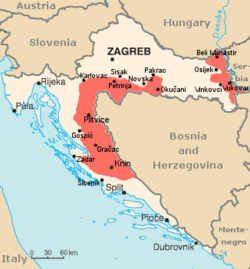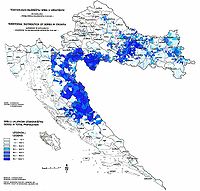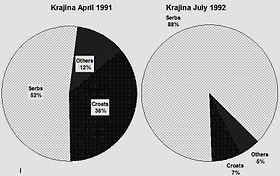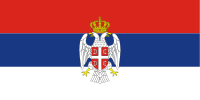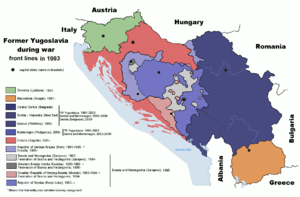- Republic of Serbian Krajina
-
Republic of Serbian Krajina
Republika Srpska Krajina
Република Српска КрајинаUnrecognized state /entity/ in Croatia ← 
←
←
1991–1995  →
→
 →
→

Flag Coat of arms Anthem
Bože PravdeCapital Knin Government Republic President - 1991–1992 Milan Babić - 1992–1994 Goran Hadžić - 1994–1995 Milan Martić Prime minister - 1991–1992 Dušan Vještica - 1992–1993 Zdravko Zečević - 1993–1994 Đorđe Bjegović - 1994–1995 Borislav Mikelić - 1995 Milan Babić Historical era Breakup of Yugoslavia - Log Revolution August 1991 - Creation of SAO SBWS 26 February 1991 - Creation of SAO Krajina 1 April 1991 - Creation of SAO Western Slavonia 12 August 1991 - Surrender of troops 10 August 1995 - Disestablished 1995 Area - 1991[1] 17,028 km2 (6,575 sq mi) Population - 1991[1] est. 286,716 Density 16.8 /km2 (43.6 /sq mi) - 1993[2] est. 435,595 - 1994 est. 430,000 Currency Krajina dinar Area source:[3] Population source:[3][4] The Republic of Serbian Krajina (RSK) (Serbian: Republika Srpska Krajina, RSK; Република Српска Крајина, РСК, Serbian pronunciation: [rɛpǔblika sr̩̂pskaː krâjina]; sometimes translated as Republic of Serb Krajina) was a self-proclaimed Serb entity within Croatia. Established in 1991, it was not recognized internationally. It formally existed from 1991 to 1995, having been initiated a year earlier via smaller separatist regions. The name Krajina means "frontier". Its separatist government engaged in a war for ethnic Serb independence from Republic of Croatia, within and out of Yugoslavia, once Croatian borders had been recognized by foreign states in August 1991 and February 1992.
The government of Krajina had de facto control over central parts of the territory while control of the outskirts changed with success and failures of the military activities. In 1992, the Serb Krajina government signed a demilitarisation agreement and removed all of the heavy artillery that were brought in by Yugoslav People's Army at the start of the conflict, in exchange the area became a United Nations Protected demilitarised zone. The territory was legally protected by the United Nations Protection Force (UNPROFOR) and the Military of Serbian Krajina that frequently attacked neighbouring Bihać enclave (then Republic of Bosnia and Herzegovina) with heavy artillery | The Daily Gazette, June 17, 1994..
Its main portion was overrun by Croatian forces in 1995; a rump remained in eastern Slavonia under UNTAES administration until its peaceful reintegration into Croatia in 1998.
Contents
Etymology
The name Krajina was adopted from the Military Frontier that was carved out of parts of the crown lands of Croatia and Slavonia by Austria between 1553–1578 as a means of defending against the expansion of the Ottoman Empire. Many Croats, Serbs and Vlachs immigrated from nearby parts of Ottoman Empire (Ottoman Bosnia and Serbia) into the region and helped bolster and replenish the numbers of Croats as well as the garrisoned German troops in the fight against the Ottomans. The Austrians controlled the Frontier from military headquarters in Vienna and did not make it a crown land, though it had some special rights in order to encourage settlement in an otherwise deserted, war-ravaged territory. The abolition of the military rule took place between 1869 and 1871. In order to attract Serbs to be part of Croatia on the 11th of May, 1867 the Sabor solemnly declared that "the Triune Kingdom recognizes the Serbian/Vlach people living in it as a nation identical and equal with the Croatian nation." After that, the Military Frontier was reincorporated in Croatia in 1881.
 Map of the original Krajina, the Military Frontier
Map of the original Krajina, the Military Frontier
Following World War I, the regions formerly part of the Military Frontier became part of Kingdom of Yugoslavia where it was in the Sava Banovina with most of old Croatia-Slavonia. Between the two world wars the Serbs of the Croatian and Slavonian Krajinas, as well as the Bosnian Krajina and other regions west of Serbia, organized a notable political party, the Independent Democratic Party under Svetozar Pribićević. In the new state there existed much tension between the Croats and Serbs over differing political visions, with the campaign for Croatian autonomy culminating in the assassination of their leader Stjepan Radić in the parliament and repression by the Serb dominated security structures.
Between 1939–1941, in an attempt to resolve the Croat-Serb political and social antagonism in the first Yugoslavia, an autonomous Banovina of Croatia was created incorporating (amongst other territories) much of the former Military Frontier as well as parts of Bosnia and Herzegovina. In 1941, the axis powers invaded Yugoslavia and in the aftermath the Independent State of Croatia (which included whole of today's Bosnia and Herzegovina and parts of Serbia (Eastern Syrmia) as well) was declared. The Ustaše (who were allegedly behind the assassination of the Serbian king of Yugoslavia) were installed by the Germans as rulers of the new country and promptly pursued a genocidal policy of persecution of Serbs, Jews and Croats (from opposition groups) leading to hundreds of thousands being killed. During this period, Croats coalesced around the ruling authorities or the communist anti-fascist Partisans. Serbs from around the Knin area tended to join the chetniks, whilst Serbs from the Banovina and Slavonia regions tended to join the Partisans.
At the end of the war, the communist dominated Partisans prevailed and the region was part of the People's Republic of Croatia until 7 April 1963, when the federal republic changed its name to the Socialist Republic of Croatia. The autonomous political organisations of the region were also suppressed by Tito (along with others such as the Croatian Spring); however, the Yugoslav constitutions of 1965 and 1974 did give substantial rights to national minorities including the Serbs in SR Croatia.
The Serbian "Krajina" entity to emerge upon Croatia's declaration of independence in 1991 would include three kinds of territories:
- a large section of the historical Military Frontier, in areas with a majority of Serbian population;
- areas such as parts of northern Dalmatia, that were never part of the Frontier but had a majority or a plurality of Serbian population, including the self-proclaimed entity's capital, Knin;
- areas that bordered with Serbia and where Serbs are significant minority (Baranja, Vukovar).
Large sections of the historical Military Frontier were outside of the Republic of Serb Krajina and contained a largely Croat population including much of Lika, the area centred around the city of Bjelovar, central and south-eastern Slavonia.
Creation
The Serb-populated regions in Croatia were of central concern to the Serbian nationalist movement of the late 1980s, led by Slobodan Milošević. The incidents started in 1988 and turned into full-scale Serbian political rallies in 1989. The Croatian pro-independence victory in 1990 made matters more tense, especially since the country's Serbian minority was supported both politically and militarily by the Yugoslav People's Army, especially Serbian President Milošević. At the time, Serbs comprised about 12.2% of Croatia's population: 581,663 people declared themselves Serbs in the census of 1991.
Serbs became increasingly opposed to the policies of Franjo Tuđman, elected president of Croatia in April 1990, due to his overt desire for the creation of an independent Croatia. On May 30, 1990 the Serb Democratic Party of Jovan Rašković broke all ties to the Croatian parliament. The following June in Knin, the Serbs—led by the Serb Democratic Party—proclaimed the creation of the Association of Municipalities of Northern Dalmatia and Lika. In August 1990, the Serbs began what became known as the Log Revolution, where barricades of logs were placed across roads throughout the South as an expression of their secession from Croatia. This effectively cut Croatia in two, separating the coastal region of Dalmatia from the rest of the country. The Croatian constitution was passed in December, 1990 putting Serbs in a minority category along with other ethnic groups such as Italians, Hungarians, and others. Some would later justify their claim to an independent Serb state by arguing that the new constitution contradicted the Constitution of the Socialist Federal Republic of Yugoslavia, because in their view, Croatia was still legally governed by the Socialist Federal Republic of Yugoslavia. This was contradicted by the increased signs of fragmentation within the Yugoslav republics. Croatian leaders officially insisted on the goal of an independent Croatia as a member of Yugoslav confederation of independent states.
Serbs in Croatia had established a Serbian National Council in July 1990 to coordinate opposition to Croatian independence. Their position was that if Croatia could secede from Yugoslavia, then the Serbs could secede from Croatia. Milan Babić, a dentist from the southern town of Knin, was elected president. At his ICTY trial in 2004, he claimed that "during the events [of 1990-1992], and in particular at the beginning of his political career, he was strongly influenced and misled by Serbian propaganda, which repeatedly referred to the imminent threat of a Croatian genocide perpetrated on the Serbs in Croatia, thus creating an atmosphere of hatred and fear of Croats."[5]
The rebel Croatian Serbs established a number of paramilitary militias under the leadership of Milan Martić, the police chief in Knin.
In August 1990, a referendum was held in the Krajina on the question of Serb "sovereignty and autonomy" in Croatia. The resolution was confined exclusively to Serbs so it passed by a majority of 99.7%. As expected, it was declared illegal and invalid by the Croatian government, who stated that Serbs had no constitutional right to break away from Croatian legal territory.
Babić's administration announced the creation of a Serbian Autonomous Oblast of Krajina (or SAO Krajina) on 21 December 1990. On 16 March 1991 another referendum was held which asked "Are you in favour of the SAO Krajina joining the Republic of Serbia and staying in Yugoslavia with Serbia, Montenegro and others who wish to preserve Yugoslavia?". With 99.8% voting in favour, the referendum was approved and the Krajina assembly declared that "the territory of the SAO Krajina is a constitutive part of the unified state territory of the Republic of Serbia".[6] On 1 April 1991, it declared that it would secede from Croatia.[7] Other Serb-dominated communities in eastern Croatia announced that they would also join SAO Krajina and ceased paying taxes to the Zagreb government, and began implementing its own currency system, army regiments, and postal service.
Croatia held a referendum on independence on 19 May 1991, in which the electorate—minus many Serbs, who chose to boycott it—voted overwhelmingly for independence with the option of confederate union with other Yugoslav states. On 25 June 1991, Croatia and Slovenia both declared their independence from Yugoslavia. As the JNA attempted unsuccessfully to suppress Slovenia's independence in the short Slovenian War, clashes between rebelled Croatian Serbs and Croatian security forces broke out almost immediately, leaving dozens dead on both sides. Serbs calling themselves Chetniks[8] were supported by the remnants of the JNA (whose members were now only from Serbia and Montenegro), which provided them military arms. Many Croatians fled their homes in fear, or were forced out by the rebel Serbs. The European Union and United Nations attempted to broker ceasefires and peace settlements, but all to no avail.
Around August 1991, the leadership of the Serbian Krajina, and that of Serbia, allegedly agreed to embark on a campaign which the ICTY prosecutors described as a "joint criminal enterprise" whose purpose "was the forcible removal of the majority of the Croat and other non-Serb population from approximately one-third of the territory of the Republic of Croatia, an area he planned to become part of a new Serb-dominated state."[9] The leaders are documented to have included Milan Babić, and other rebelled Croatian Serbs' figures such as Milan Martić, the Serbian militia leader Vojislav Šešelj and Yugoslav Army commanders including General Ratko Mladić, who was at the time the commander of JNA forces in Croatia.
According to testimony given by Babić in his subsequent war crimes trial, during the summer of 1991 the Serbian secret police—under Milošević's command—set up "a parallel structure of state security and the police of Krajina and units commanded by the state security of Serbia". Shadowy groups of paramilitaries with names such as the "Vukovi sa Vucjaka" ("Wolves from Vucjak") and the "Beli Orlovi" ("White Eagles"), funded by the Serbian secret police, were also a key component of this structure.[10]
A wider-scale war was launched in August 1991. Over the following months, a large area of territory, amounting to a third of Croatia, was controlled by the rebel Serbs. The Croatian population suffered heavily, fleeing or evicted with numerous killings, leading to ethnic cleansing.[11] The bulk of the fighting occurred between August and December 1991 when approximately 80,000 Croats were expelled (and some were killed).[12] Many more died and or were displaced in fighting in eastern Slavonia (this territory along the Croatian/Serbian border was not part of the Krajina, and it was the JNA that was the principal actor in that part of the conflict). The total number of exiled Croats and other non-Serbs range from 170,000 (ICTY)[13] up to a quarter of a million people (Human Rights Watch).[14] The Gospić massacre was one of the war crimes committed by Croatian military against the Serbian civilians.
In the latter half of 1991, Croatia was beginning to form an army and their main defenders, the local police, were overpowered by the JNA military who supported rebelled Croatian Serbs. The RSK was located entirely inland, but they soon started advancing deeper into Croatian territory.[11] Among other places, they shelled the Croatian coastal town of Zadar killing over 80 people in nearby areas and damaging the Maslenica Bridge that connected northern and southern Croatia, in the Operation Coast-91. They also tried to overtake Šibenik, but the defenders successfully repelled the attack by JNA, in the Battle of Šibenik. The main city theatre was also bombed by JNA forces.[15] The city of Vukovar, however, was completely devastated by JNA attacks.[16] The city of Vukovar that warded off JNA attacks for months eventually fell, ending the Battle of Vukovar. 2,000 defenders of Vukovar and civilians were killed, 800 went missing and 22,000 were forced into exile.[17][18] The wounded were taken from Vukovar Hospital to Ovcara near Vukovar where they were executed.[19]
On 19 December 1991, the SAO Krajina proclaimed itself the Republic of Serbian Krajina. On 26 February 1992, the SAO Western Slavonia and SAO Slavonia, Baranja and Western Srem were added to the RSK, which initially had only encompassed the territories within the SAO Krajina. The Serb Army of Krajina (Српска Војска Крајине / Srpska Vojska Krajine ; abbreviated СВК / SVK) (or the Republic of Serbian Krajina Army) was officially formed on 19 March 1992. The RSK occupied an area of some 17,028 km² at its greatest extent.
1992 ceasefire
A ceasefire agreement was signed by Presidents Tuđman and Milošević in January 1992, paving the way for the implementation of a United Nations peace plan put forward by Cyrus Vance. Under the Vance Plan, four United Nations Protected Areas (UNPAs) were established in Croatian territory which was claimed by RSK. The Vance Plan called for the withdrawal of the JNA from Croatia and for the return of refugees to their homes in the UNPAs. The JNA officially withdrew from Croatia in May 1992 but much of its weaponry and many of its personnel remained in the Serb-held areas and were turned over to the RSK's security forces. Refugees were not allowed to return to their homes and many of the remaining Croats and other nationalities left in the RSK were expelled or killed in the following months.[16][20] On 21 February 1992, the creation of the United Nations Protection Force (UNPROFOR) was authorised by the UN Security Council for an initial period of a year, to provide security to the UNPAs.
The agreement effectively froze the front lines for the next three years. Croatia and the RSK had effectively fought each other to a standstill. The Republic of Serbian Krajina was not recognised de jure by any other country or international organisation. Nevertheless it gained support from Serbia's allies, Greece, Russia, and Romania.
With the creation of new Croatian counties on 30 December 1992, the Croatian government also set aside two autonomous regions (kotar) for ethnic Serbs in the areas of Krajina. However, Serbs considered this too late, as it was not the amount of autonomy they wanted, and by now they had declared de facto independence.
UNPROFOR was deployed throughout the region to maintain the ceasefire, although in practice its light armament and restricted rules of engagement meant that it was little more than an observer force. It proved wholly unable to ensure that refugees returned to the RSK. Indeed, the rebel Croatian Serb authorities continued to make efforts to ensure that they could never return, destroying villages and cultural and religious monuments to erase the previous existence of the Croatian inhabitants of the Krajina.[16] Milan Babić later testified that this policy was driven from Belgrade through the Serbian secret police—and ultimately Milošević—who he claimed were in control of all the administrative institutions and armed forces in the Krajina.[21] This would certainly explain why the Yugoslav National Army took the side of the rebelled Croatian Serbs in spite of its claims to be acting as a "peacekeeping" force. Milošević denied this, claiming that Babić had made it up "out of fear".
Decline
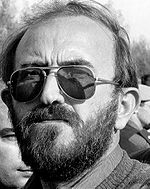 1992: RSK president Goran Hadžić.
1992: RSK president Goran Hadžić.
The partial implementation of the Vance Plan drove a wedge between the governments of the RSK and Serbia, the RSK's principal backer and supplier of fuel, arms and money. Milan Babić strongly opposed the Vance Plan but was overruled by the RSK's assembly.[16]
On 26 February 1992, Babić was deposed and replaced as President of the RSK by Goran Hadžić, a Milošević loyalist. Babić remained involved in RSK politics but as a considerably weaker figure.
The position of the RSK eroded steadily over the following three years. On the surface, the RSK had all the trappings of a state: army, parliament, president, government and ministries, currency and stamps. However its economy was wholly dependent on support from the rump Yugoslavia, which had the effect of importing that country's hyperinflation.
The economic situation soon became disastrous. By 1994, only 36,000 of the RSK's 430,000 citizens were employed. The war had severed the RSK's trade links with the rest of Croatia, leaving its few industries idle. With few natural resources of its own it had to import most of the goods and fuel it required. Agriculture was devastated, and operated at little more than a subsistence level.[4] Professionals went to Serbia or elsewhere to escape the republic's economic hardships. To make matters worse, the RSK's government was grossly corrupt and the region became a haven for black marketeering and other criminal activity. It was clear by the mid-1990s that without a peace deal or support from Yugoslavia the RSK was not economically viable.[22] This was especially evident in Belgrade, where the RSK had become an unwanted economic and political burden for Milošević. Much to his frustration, the rebel Croatian Serbs rebuffed his government's demands to settle the conflict.[16]
In July 1992 the RSK issued its own currency, the Krajina dinar (HRKR), in parallel with the Yugoslav dinar. This was followed by the "October dinar" (HRKO), first issued on 1 October 1993 and equal to 1,000,000 Reformed Dinar, and the "1994 dinar", first issued on 1 January 1994, and equal to 1,000,000,000 October dinar.
The RSK's weakness also adversely affected its armed forces, the Vojska Srpske Krajine (VSK). Since the 1992 ceasefire agreement, Croatia had spent heavily on importing weapons and training its armed forces with assistance from American contractors. In contrast, the VSK had grown steadily weaker, with its soldiers poorly motivated, trained and equipped.[16][23] There were only about 55,000 of them to cover a front of some 600 km in Croatia plus 100 km along the border with the Bihać pocket in Bosnia. With 16,000 stationed in eastern Slavonia, only about 39,000 were left to defend the main part of the RSK. Overall, only 30,000 were capable of full mobilization, yet they faced a far stronger Croatian army. Also, political divisions between Hadžić and Babić occasionally led to physical and sometimes even armed confrontations between their supporters; Babić himself was assaulted and beaten in an incident in Benkovac.[24][25]
In January 1993 the revitalized Croatian army attacked the Serbian positions around Maslenica in southern Croatia which curtailed their access to the sea via Novigrad. In a second offensive in September 1993 the Croatian army overran the Medak pocket in the southern Krajina in a push to regain Serb-held Croatian territory. This action was halted by international diplomacy but although the rebel Croatian Serbs brought reinforcements forward fairly quickly, the strength of the Croatian forces proved superior. Hadžić sent an urgent request to Belgrade for reinforcements, arms and equipment. In response, around 4,000 paramilitaries under the command of Vojislav Šešelj (the White Eagles) and "Arkan" (the Serb Volunteer Guard) arrived to bolster the VSK. They found the RSK government and military in a chaotic state.[citation needed]
Operation Storm
Main articles: Operation Flash and Operation Storm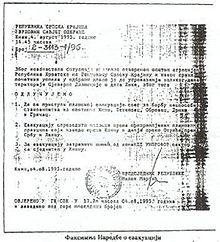 The order to evacuate ethnic Serbians from RSK territory, issued by the Serbian Ministry of Defence and signed by Milan Martić; 4 August 1995
The order to evacuate ethnic Serbians from RSK territory, issued by the Serbian Ministry of Defence and signed by Milan Martić; 4 August 1995
Following the rejection by both sides of the Z-4 plan for reintegration, the RSK's end came in 1995, when Croatian forces gained control of SAO Western Slavonia in Operation Flash (May) followed by the biggest part of occupied Croatia in Operation Storm (August). The Krajina Serb Supreme Defence Council met under president Milan Martić to discuss the situation. A decision was reached at 16:45 to "start evacuating the population unfit for military service from the municipalities of Knin, Benkovac, Obrovac, Drniš and Gračac." The RSK was disbanded and most of the Serb population fled.[16][26] Only 5,000 to 6,000 people remained, mostly the elderly.[27] The croatian historian Ivo Goldstein wrote, "The reasons for the Serb exodus are complex. Some had to leave because the Serb army forced them to, while others feared the revenge of the Croatian army or of their former Croatian neighbours, whom they had driven away and whose homes they had mostly looted (it was later shown that this fear was far from goundless).".[27]
Most of the refugees ended in Serbia, Bosnia and eastern Slavonia. Some of those who remained were murdered, tortured and forcibly expelled by the Croatian Army and police.[26] Croatia celebrates this victory on 5 August as Victory Day. There was also accusations of widespread arson committed by the Croatian soldiers, per the indictment of the Office of the Prosecutor of the ICTY, to be an action organised to prevent the Serbs from returning. This case is pending judgment.[28]
A number of Croatian army officers (such as general Ante Gotovina) were indicted by the ICTY in the Hague for command responsibility for the killings committed by Croatian soldiers against the civilian Serb population. On 15 April 2011, Croatian generals Ante Gotovina and Mladen Markač were convicted on charges of crimes against humanity and violations of the laws or customs of war; Ivan Čermak, another Croatian general, was acquitted.[28]
Later events
The parts of the former RSK in eastern Croatia (along the Danube) remained in place, in what was previously the SAO Eastern Slavonia, Baranja and Western Syrmia.
In 1995, Milan Milanović, formerly a Republic of Serbian Krajina official, signed the Erdut Agreement as a representative of the Serbian side. This agreement, co-signed by the representative of the Croatian Government, was sponsored by the United Nations.
It set up a transitional period during which the United Nations Transitional Authority for Eastern Slavonia, Baranja and Western Sirmium (UNTAES) peacekeeping mission would oversee a peaceful reintegration of this territory into Croatia, starting on January 15, 1996. In 1998, the UNTAES mission was complete and the territory was formally returned to Croatia.
After the peaceful reintegration, two Croatian islands on the Danube, the Island of Šarengrad and the Island of Vukovar, remained under Serbian military control. In 2004, Serbian military was withdrawn from the islands and replaced with Serbian police. Thus, the islands remain an open question.[29]
Demographics
According to the indictment of prosecutor Carla Del Ponte against Slobodan Milošević at the International Criminal Tribunal for the former Yugoslavia (ICTY), the Croat and non-Serb population from the 1991 census was approximately as follows:[30]
Census (1991) Serbs Croats Others Total Later RSK total 245,800 (52.3 %) 168,000 (35.8 %) 55,900 (11.9 %) 469,700 UNPA Sector North and South 170,100 (67 %) 70,700 (28 %) 13,100 (5 %) 253,900 SAO Western Slavonia 14,200 (60 %) 6,900 (29 %) 2,600 (11 %) 23,700 SAO SBWS 61,500 (32 %) 90,500 (47 %) 40,200 (21 %) 192,200 Thus Serbs comprised 52.3% and Croats 35.8% of the population of SAO Krajina respectively in 1991.
According to data set forth at the meeting of the Government of the RSK in July 1992, its ethnic composition was 88% Serbs, 7% Croats, 5% others.[24] As of November 1993, less than 400 ethnic Croats still resided in UNPA Sector South,[31] and between 1,500 and 2,000 remained in UNPA Sector North.[32]
Towns
Towns which were at one point part of RSK or occupied by the RSK's army:
Legal status
During its existence, this entity did not achieve international recognition. In January 1992, the Badinter commission concluded that Yugoslavia was "in dissolution" and that the republics - including Croatia - should be recognized as independent states when they asked so.[33][34] They also assigned these republics territorial integrity. For most of the world this was a reason to recognize Croatia. However, Serbia did not accept the conclusions of the commission in that period and recognized Croatia only after Croatian military actions (Oluja and Bljesak) and Dayton agreement.
Government
Presidents
Name Born-Died Term start Term end Political Party Milan Babić 1956–2006 19 December 1991 16 February 1992 Serbian Democratic Party Mile Paspalj (acting) 1953 - 16 February 1992 26 February 1992 Serbian Democratic Party Goran Hadžić 1958 - 26 February 1992 26 January 1994 Serbian Democratic Party Milan Martić 1954 - 26 January 1994 7 August 1995 Serbian Democratic Party Source: World Statesmen - Krajina Prime Ministers
Name Born-Died Term start Term end Political Party Dušan Vještica 19 December 1991 16 February 1992 Serbian Democratic Party Risto Matković (acting) 16 February 1992 26 February 1992 Serbian Democratic Party Zdravko Zečević 26 February 1992 21 April 1993 Serbian Democratic Party Đorđe Bjegović 1941 - 21 April 1993 27 March 1994 Serbian Party of Socialists Borislav Mikelić 1939 - 27 March 1994 27 July 1995 Serbian Democratic Party Milan Babić 1956–2006 27 July 1995 7 August 1995 Serbian Democratic Party Source: World Statesmen - Krajina Government in exile
There exists a self-proclaimed government in exile for the Republic of Serbian Krajina. This government existed for a short time period after Operation Storm, but was reconstituted in 2005. This self-proclaimed government has changed the official name of the Republic of Serbian Krajina to Republic of Serb-Krajina.[35] At the Belgrade meeting, the former legislators declared themselves to be the legitimate continuation of the RSK government and called for the re-creation of the RSK on the basis of the 1994 Z-4 plan, which had called for Krajina to have a status of "more than autonomy, less than independence" within Croatia.[36] They announced that a parliamentary election would be held and that the new name of the self-proclaimed state would be "Republic of Serb-Krajina". The meeting elected Milorad Buha as prime minister as well as six ministers without portfolio whose names were not revealed.
This move was criticized by many, including top Serbian and Croatian government officials, as well as senior representatives of Serbs in Croatia. They all stated that such a meeting would harm Serb-Croat reconciliation and relations between the communities in Croatia. It was pointed out that the Krajina Serb legislators had rejected the Z-4 proposal when it had originally been put forward. Some Serbian nationalists also criticized the move, saying that a government in exile should have been created as soon as possible after Operation Storm, not 10 years later.
See also
- Arbitration Commission of the Peace Conference on the former Yugoslavia
- Military of Serbian Krajina
- Croatian War of Independence
- Republika Srpska
- Serbs of Croatia
- Index of Serbs of Croatia-related articles
Notes
- ^ http://www.worldstatesmen.org/Croatia.html#Krajina
- ^ http://www.worldstatesmen.org/Croatia.html#Krajina
- ^ a b Klajn, Lajčo (2007). The Past in Present Times: The Yugoslav Saga. p. 199. University Press of America. ISBN 0761836470.
- ^ a b Svarm, Filip (15 August 1994). The Krajina Economy. Vreme News Digest Agency. Accessed 8 July 2009.
- ^ Milan Babic - Sentencing Judgement. International Criminal Tribunal for the former Yugoslavia. Accessed 8 July 2009.
- ^ Prosecutor v. Milan Martić Judgement. p. 46. International Criminal Tribunal for the former Yugoslavia. Accessed 13 September 2009.
- ^ Chuck Sudetic (April 2, 1991). "Rebel Serbs Complicate Rift on Yugoslav Unity". The New York Times. http://www.nytimes.com/1991/04/02/world/rebel-serbs-complicate-rift-on-yugoslav-unity.html?ref=croatia. Retrieved December 11, 2010.
- ^ Profile: Vojislav Seselj. BBC (7 November 2007). Accessed 13 September 2009.
- ^ Judge Rodrigues confirms Indictment charging Slobodan Milosevic with Crimes committed in Croatia. International Criminal Tribunal for the former Yugoslavia. Accessed 13 September 2009.
- ^ Seselj indictment
- ^ a b ICTY evidence; Babic pleads guilty to crimes
- ^ Croatian refugees
- ^ Marlise Simons (October 10, 2001). "Milosevic, Indicted Again, Is Charged With Crimes in Croatia". New York Times. http://www.nytimes.com/2001/10/10/world/milosevic-indicted-again-is-charged-with-crimes-in-croatia.html?scp=1&sq=milo%C5%A1evi%C4%87%20170000&st=cse. Retrieved December 26, 2010.
- ^ "Milosevic: Important New Charges on Croatia". Human Rights Watch. October 21, 2001. http://www.hrw.org/en/news/2001/10/28/milosevic-important-new-charges-croatia. Retrieved October 29, 2010.
- ^ Sibenik theatre destroyed
- ^ a b c d e f g Tanner, Marcus (1997) Croatia: A Nation Forged in War.
- ^ Vukovar death toll
- ^ Croatia marks massacre in Vukovar. BBC (18 November 2006). Accessed 13 September 2009.
- ^ Partos, Gabriel (13 June 2003). Vukovar massacre: What happened. BBC. Accessed 13 September 2009.
- ^ "Babic admits persecuting Croats". BBC News. 27 January 2004. http://news.bbc.co.uk/2/hi/europe/3433721.stm. Retrieved 22 May 2010.
- ^ Babic testifies against Milosevic
- ^ Milosevic and the JNA http://hrw.org/reports/2006/milosevic1206/4.htm#
- ^ Testimony from RSK generals http://www.nsf-journal.hr/issues/v3_n3-4/11.htm
- ^ a b Republika Hrvatska i Domovinski rat 1990. - 1995. dokumenti (Croatian)
- ^ Krušelj, Željko (October 22, 2005). "U ljeto '91. pripremana i pobuna u Gorskom kotaru" (in Croatian) (PDF). Vjesnik. http://www.vjesnik.hr/Pdf/2005%5C10%5C22%5C30A30.PDF. Retrieved 2009-08-05.
- ^ a b Amnesty International, Croatia: Operation "Storm" - still no justice ten years on, 04.08.2005
- ^ a b Goldstein, Ivo (1999). Croatia: A History. p. 253–254. C. Hurst & Co. Publishers. ISBN 1850655251.
- ^ a b Gotovina indictment http://www.un.org/icty/cases-e/cis/gotovina/cis-gotovina.pdf
- ^ [1] Serbian refusal of Badinter Arbitration Committee decision on Serbian
- ^ The Prosecutor of the Tribunial Against Slobodan Milosevic. International Criminal Tribunal for the former Yugoslavia. Accessed 13 September 2009.
- ^ U.S. DEPARTMENT OF STATE (January 31, 1994), CROATIA HUMAN RIGHTS PRACTICES, 1993; Section 2, part d., http://www.hri.org/docs/USSD-Rights/93/Croatia93.html
- ^ United Nations Economic and Social Council Commission on Human Rights, SITUATION OF HUMAN RIGHTS IN THE TERRITORY OF THE FORMER YUGOSLAVIA, Section J, Points 147 and 150, http://www.unhchr.ch/Huridocda/Huridoca.nsf/2848af408d01ec0ac1256609004e770b/5793c2d636a30ac9802566710057034c?OpenDocument
- ^ http://lawreview.kentlaw.edu/articles/80-1/Hasani%20PDF3.pdf
- ^ The Opinions of the Badinter Arbitration Committee: A Second Breath for the Self-Determination of Peoples
- ^ http://www.vladarsk.com/
- ^ "Dokumenti: Plan Z-4" (in Serbian). B92 specijal: 10 godina od Oluje nad Krajinom. B92. http://www.b92.net/specijal/oluja/index.php?start=0&nav_id=173983. Retrieved 2010-11-02.
References
- (Croatian) Barić, Nikica: Srpska pobuna u Hrvatskoj 1990.-1995., Golden marketing. Tehnička knjiga, Zagreb, 2005., ISBN 953-212-249-4
- (Croatian) HIC Ratni zločini srpskih vojnih i paravojnih postrojbi u Lici i sjevernoj Dalmaciji 1991. - 1995.
- (Croatian) Mass Killing and Genocide in Croatia 1991./92., Ministarstvo zdravstva RH, 1992.
- Ratni zločini u BiH, Helsinki Watch, 1992.
- "The Army of Serbian Krajina", Jane's Intelligence Review, 1 October 1993
- Final Report of the United Nations Commission of Experts, 28 December 1994: The military structure, strategy and tactics of the warring factions
- "Operation Storm - Attack on the Krajina", Jane's Intelligence Review, 1 November 1995
- (Croatian) Državno odvjetništvo Podnijet istražni zahtjev protiv više osoba zbog ratnog zločina protiv civilnog stanovništva i ratnog zločina protiv ratnih zarobljenika
External links
- The Homeland War
- (Croatian) Slobodna Dalmacija Granić kaže da Haag nema dokumente o agresiji na Hrvatsku?
- (Serbian/English) Glas prognanih Krajisnika / Voice of exiled Krajishniks Krajinaforce
- (English) Resolution adopted by the General Assembly of the United Nations A/RES/49/43 The situation in the occupied territories of Croatia
- Map (from a site run by minister of intelligence of RSK)
Categories:- Former republics
- Former countries in the Balkans
- Former unrecognized countries
- States and territories established in 1991
- States and territories disestablished in 1995
- 1995 disestablishments
- Secession in Croatia
- Former Slavic countries
- Republic of Serbian Krajina
Wikimedia Foundation. 2010.

